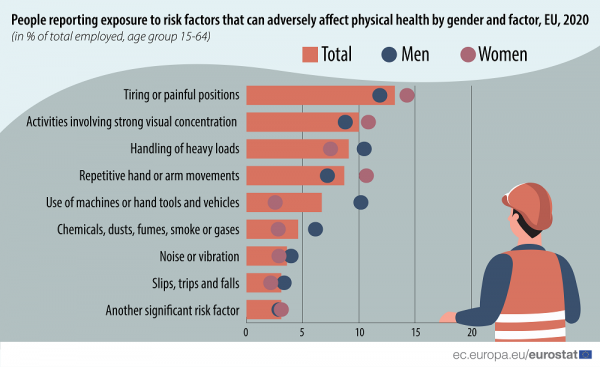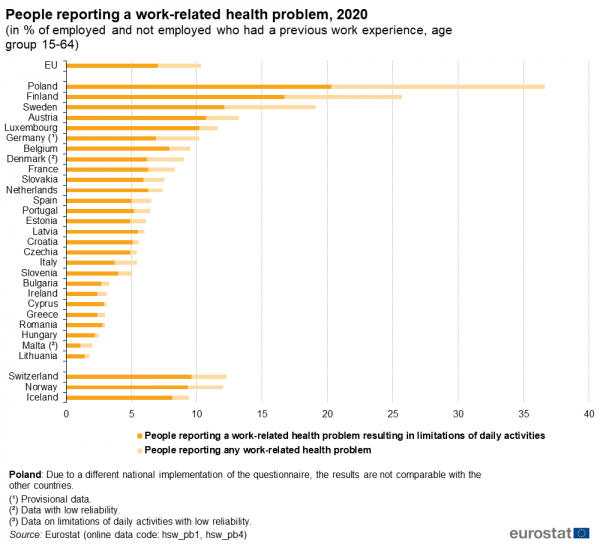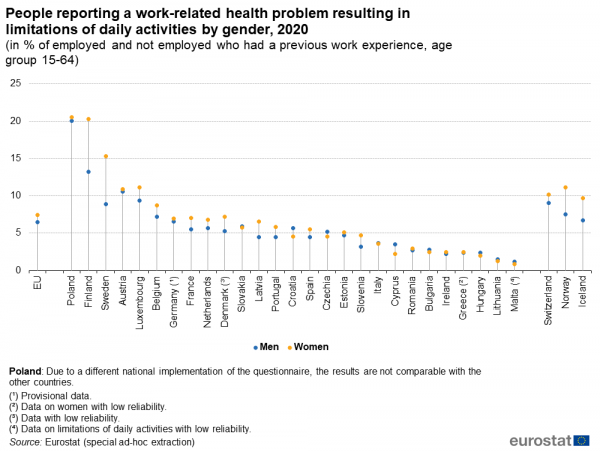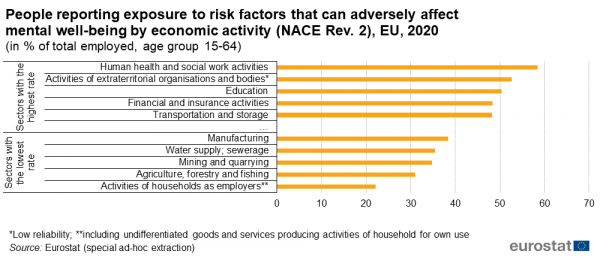Self-reported work-related health problems and risk factors - key statistics
Data extracted in September 2021
Planned article update: 2029 (with availability of LFS 2028 module)
Highlights
In 2020, 10.3 % of EU workers reported having had work-related health problems during the previous year.
At EU level in 2020, 6.0 % of workers suffered from bone, joint or muscle problems, caused or made worse by their job during the previous year.
In 2020, the proportion of employed people who reported facing risk factors for their mental well-being at work stood at 44.6 % at EU level.
This article presents main statistical results concerning work-related health problems and risk factors for people at work in the European Union (EU) and the European Free Trade Association (EFTA). The data were collected within the framework of the 2007, 2013 and 2020 ad hoc modules of the EU labour force survey (EU-LFS) and cover people aged 15 to 64.
“Work-related health problems” include all health problems (physical or mental health problems, illnesses, disabilities) which the respondent had suffered during the year before the end of the reference week of the survey and which the respondent considered as being caused or made worse by his/her current or past job. This means that health problems and their causality are self-perceived and not restricted to cases reported or recognised by authorities. In addition, it does not necessarily mean that the health problems are accompanied by sick leave or medical treatment.
The analysis of work-related health problems is complemented with information on the subjective perception of people on being exposed to risk factors at work that might endanger their physical health or might have an impact on their mental well-being (including mental health).
The analysis in this article focuses on health problems other than accidents. For information on accidents at work, visit the article on self-reported accidents at work or check the data on fatal and non-fatal accidents at work from the administrative data collection European Statistics on Accidents at Work (ESAW).
Full article
An overview at EU level of the proportion of people reporting a work-related health problem over the course of the last three rounds of implementation of the EU-LFS module on "Accidents at work and work-related problems", i.e. in 2007, 2013 and 2020, is presented in Figure 1. In the most recent year, 2020, 10.3 % of people in the age group 15-64 reported having had work-related health problems during the previous 12 months, a higher rate than that recorded in 2013 (8.8 %), but substantially lower than in 2007 (14.6 %). Note that these figures relate to the share of people who had (ever) worked and not just to people in work at the time of the survey.

Source: Eurostat (hsw_pb1)
Still focusing on the age group 15-64, in 2007 the shares of men and women reporting a work-related health problem were very close showing only a 0.2 percentage point (p.p.) difference. In the following two rounds of the module, this difference widened to around 1 p.p. as women showed slightly higher rates than men. In 2020, 10.8 % of women reported a work-related health problem against 9.8 % of men.
The breakdown by age reveals considerably more differences than the gender breakdown. In 2020, the share of young people (aged 15-34) reporting work-related health problems (6.5 %) was much lower than the one for people aged 35-54 (10.8 %), which in turn was much lower than for people aged 55-64 (14.1 %). A similar tendency could be seen for 2007 and 2013.
Looking at 2020 results, it is also worth noticing that the gender gap seems to narrow proportionally with age as it is 1.3 p.p. for the age group 15-34, 1.2 p.p. for people aged 35-54, and almost disappears for people aged 55-64 (0.1 p.p.).
When comparing the results of work-related health problems in 2020 with the previous years, one should keep in mind the potential impact of the COVID-19 crisis, not only in terms of health consequences on people, but also with regard to the new way of working imposed by the pandemic (e.g. increased rate of teleworking) and the reduced economic activity.
Prevalence and ramifications
The prevalence of work-related health problems among the different countries in 2020 is shown in Figure 2. Greece and Romania (both 3.0 %), Hungary (2.5 %), Malta (2.0 %) and Lithuania (1.8 %) registered the lowest shares of people having had work-related health problems in the previous 12 months. In contrast, this share exceeded 10 % in Germany (10.2 %), Luxembourg (11.6 %), Austria (13.2 %), Sweden (19.1 %) and Finland (25.7 %). In addition, EFTA countries Switzerland (12.3 %) and Norway (12.0 %) also showed shares above 10 %. Poland also stands out with a relatively very high rate (36.6 %); however, due to a different national implementation of the survey’s questionnaire, the Polish results are not completely comparable with those from the other countries.
It should be noted that the significant differences between countries may originate not only in different working conditions and economic structures but also in differences in the awareness, treatment, compensation, reporting and prevention of work-related health problems. Furthermore, there may be cultural differences in how people perceive their own health and to what extent they are willing to share information on it.
The prevalence of work-related health problems resulting in limitations of daily activities (including some and severe limitations) can be also seen in Figure 2. It should be noted that accounting for the limitations of daily activities provides a better understanding of the impact of health problems. It should also be considered that daily activities include not only work-related activities but also private activities. At EU level, more than two-thirds (exactly 71.0 %) of people reporting a work-related health problem had limitations in daily activities as a consequence; this corresponds to 7.0 % of the total EU population of (currently) employed and previously employed people. Among the EU Member States with comparable data, Finland (16.7 %) and Sweden (12.1 %) again ranked at the top of the scale, however with smaller percentages than if only people reporting any work-related health problem are considered. The difference between the shares of people reporting any work-related health problem and work-related health problem with limitations of daily activities as consequence is much starker in Poland (36.6 % compared with 20.3 %).
At EU level, 6.5 % of men with work experience reported a work-related health problem limiting their daily activities; a slightly higher share was recorded for women - 7.4 % (see Figure 3). In 18 out of 27 EU countries, the share of women exceeded those of men. The widest gender gaps among these Member States were recorded in Latvia, Sweden and Finland, where the share of women was higher with 2.0 p.p., 6.4 p.p. and 7.1 p.p. respectively than the share of men. The gender difference, in the remaining nine EU countries where the share of men was higher than the share of women, does not exceed 1.5 p.p.
Figure 4 allows for a more in-depth analysis of the ramifications of work-related health problems regarding the level of limitations in daily activities. In the EU, 29.0 % of people reporting a work-related health problem in 2020 had no limitations in daily activities as a result, 48.9 % had some limitations and 22.1 % had severe limitations. More than half the people reporting a work-related health problem in Portugal, the Netherlands and Latvia had severe limitations in daily activities because of the health problem, while these were less than 15 % in Slovakia, Finland, Poland and Italy. At the same time, more than two-thirds of people reporting a work-related health problem in Romania, Slovakia and Czechia, admitted to having some limitations in daily activities as a result, while this share falls to less than one-third in Malta, Sweden and Portugal.

Source: Eurostat (hsw_pb4)
Another way of assessing the ramifications of work-related health problems is by looking at the duration of time off work caused by the problem. The 2020 results show that at EU level, half the people reporting a work-related health problem had less than a day or no time off work due to the problem (see Figure 5). For another 7 %, the duration of the time off was between one and three days, while absences between four days to less than a month (16 %) were much more common for people with a work-related health problem. Smaller shares were recorded for absences with a duration of one to three months (6 %), three to six months (3 %) and for the absences which took more than six months off work (10 %).

Source: Eurostat (hsw_pb3)
Most affected sectors of economy and groups of occupations
Information presented in this section is based on the economic activity (NACE Rev. 2) and occupation (ISCO-08) of people’s actual job, which caused or worsened the health problem. This might be the main, second or previous job.
In 2020, Agriculture, forestry and fishing (15.8 %) was the sector of economic activity with the highest prevalence of people having had a work-related health problem in the previous 12 months (see Figure 6, EU level). Human health and social work activities (12.7 %) and the sector Transportation and storage (12.4 %) followed as the second and third most affected sectors of the economy. Other sectors with more than 10 % of people reporting work-related health problems were Construction (12.0 %), Education (11.1 %) and Industry (except construction) with 10.6 %. In contrast, the sectors of Information and communication (7.6 %) and Professional, scientific and technical activities (7.3 %) ranked as the sectors with the lowest prevalence of work-related health problems.
Looking at the different groups of occupations at EU level, shown in Figure 7, the skilled agricultural and fishery workers (16.9 %), plant and machine operators and assemblers (12.5 %), craft and related trades workers (12.3 %) and the group of those with elementary occupations (11.2 %) had the highest proportion of workers reporting a work-related health problem. At the opposite end of the scale, with the lowest shares, were the professionals (9.3 %), legislators, senior officials and managers (9.0 %) and clerks (8.0 %).
As can be seen in Figure 8, the most common type of work-related health problem is musculoskeletal disorders (i.e. bone, joint or muscle problems), affecting 6.0 % of total employed or previously employed people in the age group 15-64 at EU level. Men and women aged 15-64 suffering from this problem show no major difference, as the share for both genders is quite similar (5.9 % for men and 6.0 % for women). The second-largest group was for work-related health problems concerning stress, depression or anxiety, mentioned by 1.9 % of people. Furthermore, gender differences here are slightly more pronounced, as stress, depression or anxiety affected 1.5 % of men and 2.2 % of women aged 15 to 64. Finally, headaches, eye-strains or migraines, with 0.7 % for the total current or ex-workers aged 15-64, represented the third most common work-related health problem; this share amounted to 0.5 % for men and 0.8 % for women.
It is worth remembering that work-related health problems in this article are problems that were caused or made worse by the job and have affected people’s health in the course of the previous 12 months. It is also worth mentioning that in the survey people report the type of only the most serious work-related health problem, which means that some people may have more than one work-related health issue.
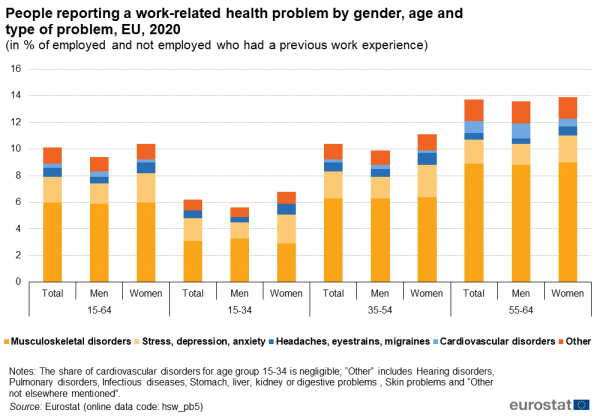
Source: Eurostat (hsw_pb5)
Looking at the different age groups, it appears that the levels of stress, depression or anxiety remain quite stable over the generations, at a rate of around 2 % for the total employed or previously employed people. However, for musculoskeletal disorders, the share increases proportionally with age: 3.1 % for the age group 15-34, 6.3 % for 35-54 and 8.9 % for those in the age group 55-64. Another age-related aspect is that cardiovascular disorders do not appear for the younger generation (aged 15-34); however, they slightly affect the age group 35-54, with 0.2 % reporting a cardiovascular disorder caused or made worse by the job. The share for older people (aged 54-64) reached 0.9 %, being slightly higher for men (1.1 %) than for women (0.6 %) in this age group.
Figure 9 focuses on country level with regard to people reporting musculoskeletal disorders, which had been caused or made worse by the job. Among the EU countries with comparable data, Finland (15.8 %) registered the highest share. Austria (8.8 %), Sweden (7.3 %) and Slovakia (5.2 %) followed by a distance. In contrast, less than 2 % of workers in Romania, Bulgaria, Hungary, Ireland, Lithuania and Malta declared work-related musculoskeletal disorders. Looking at the gender differences, the shares of men and women are close among the EU Member States; an exception to this pattern is Finland with a relatively larger gender gap of 4.2 p.p.
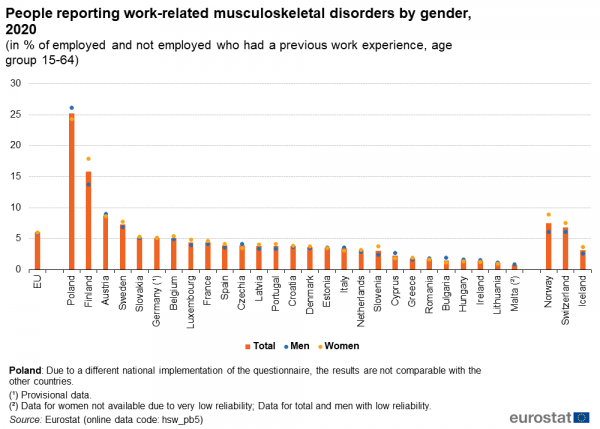
Source: Eurostat (hsw_pb5)
The levels of work-related stress, depression or anxiety are shown in Figure 10. The highest share of workers who declared having stress, depression or anxiety caused or made worse by the job was found in Sweden (8.6 %), followed by a distance by Luxembourg (3.6 %) and Finland (3.5 %). In the south and eastern European countries, Czechia, Slovakia, Lithuania, Cyprus, Hungary, Greece, Bulgaria and Romania, the rate fell below 0.5 %. In the vast majority of EU countries for which data is available for both genders, the share for women is higher than the share for men, with the largest gaps found in Sweden (6.2 p.p.), Finland (1.9 p.p.), Denmark (1.5 p.p.) and France (1.3 p.p.). Exceptions to this pattern are Croatia with a slightly higher share for men than for women (0.4 p.p. difference) as well as Lithuania, Greece and Slovakia with equal shares for both genders.
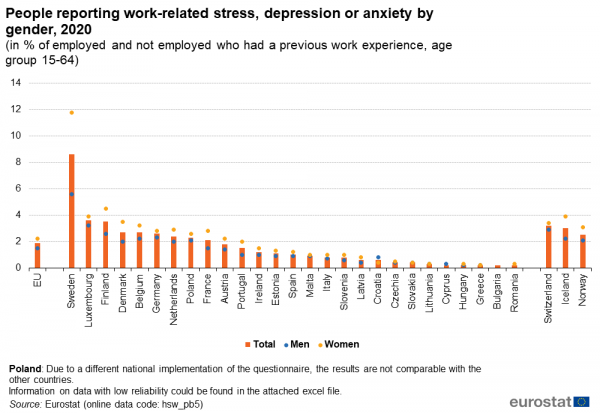
Source: Eurostat (hsw_pb5)
Exposure to physical risk factors at work
At EU level, in 2020, 62.3 % of the employed population aged 15-64 reported being exposed to risk factors at work that could affect their physical health (see Figure 11). The highest shares among the EU countries were recorded in Portugal (84.1 %), the Netherlands (81.7 %), Austria (79.3 %), Sweden (78.2 %) and Luxembourg (77.7 %). Furthermore, 17 other Member States also registered shares above 50 %. Looking at the EFTA countries, Norway recorded 85.4 %, i.e. a higher share than the EU. In contrast, the lowest rates, below 50 %, were found in Malta (48.5 %), Czechia (47.3 %), Lithuania (44.1 %), Denmark (43.2 %) and Germany (32.9 %).

Source: Eurostat (hsw_exp2)
In all countries, the share of people declaring exposure to physical risks at work was higher among men than women. Slovakia, Lithuania, Czechia and Cyprus reported the most pronounced gender differences, with shares for men in these countries being higher than the shares recorded for women with 20.6 p.p., 17.6 p.p., 14.5 p.p. and 14.3 p.p. respectively. In contrast, the shares for both genders in Denmark were very close, resulting in a gender gap of 0.4 p.p.
The type of different physical risk factors at EU level is shown in Figure 12. Tiring or painful positions (13.2 %), activities involving strong visual concentration (10.0 %), handling of heavy loads (9.1 %) and repetitive hand or arm movements (8.7 %) were mentioned by most people as the most serious risk factors for their physical health at work.
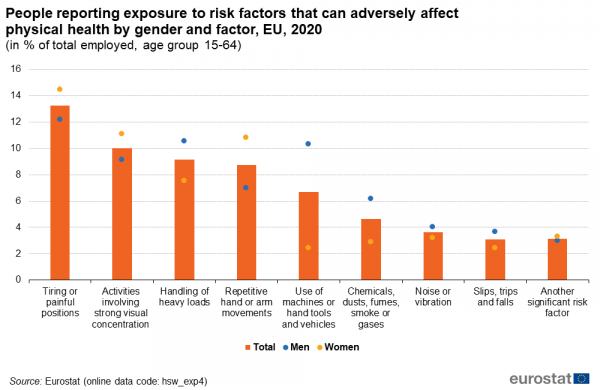
Source: Eurostat (hsw_exp4)
Different types of physical risks show emphasized gender differences. Repetitive movements were more commonly mentioned by women than men (10.8 % compared with 7.0 %); the same pattern can be seen regarding a tiring or painful position, which was declared as the most serious physical risk factor by 14.5 % of women versus 12.2 % of men. Conversely, the use of machines or hand tools and vehicles - showing the largest gender gap - was deemed by 10.3 % of men as the most serious risk factor at work, compared with 2.4 % of women.
Regarding the sectors of economic activity, Agriculture, forestry and fishing stood out as the sector with the highest share of employed people reporting exposure to physical risk factors at work, with 77.4 % (see Figure 13). The sectors Mining and quarrying (76.7 %) and Construction (76.3 %) followed, as more than three-quarters of thier workers reported exposure to physical risks. Activities of households as employers (50.3 %), Financial and insurance activities (47.4 %) and Real estate activities (45.2 %) fell at the opposite end of the ranking with the smallest percentages of people declaring physical risk factors at work.
Exposure to mental risk factors at work
The proportion of people who reported facing risk factors for their mental well-being at work is displayed in Figure 14. At EU level, in 2020, this share represented 44.6 % of the total employed population aged 15-64. In 11 Member States, the share of people reporting mental well-being risks at work exceeded half of all employed people. Among these, Sweden (76.4 %), Greece (69.1 %) and Luxembourg (67.4 %) had the highest values. In contrast, the lowest shares were found in Czechia (33.8 %), Lithuania (26.7 %) and Germany (25.8 %).

Source: Eurostat (hsw_exp1)
Apart from Greece, Cyprus, Luxembourg and Switzerland, all other countries registered higher shares for women than for men with regard to reporting risk factors that can adversely affect mental well-being. The widest gender gaps were recorded in Finland, Latvia and Croatia, where the share for women was higher by 15.8 p.p., 9.5 p.p. and 9.2 p.p. respectively than the share recorded for their male counterparts.
Time pressure or work overload was the most commonly mentioned risk factor for mental well-being at work, as it was reported by almost one-fifth (exactly 19.5 %) of employed people in the EU (see Figure 15). Dealing with difficult customers, patients, pupils, etc. and job insecurity were the second and third most frequent risk factors for mental well-being that people reported having at work, mentioned by, respectively 10.4 % and 6.1 %.

Source: Eurostat (hsw_exp3)
In summary, the different risk factors for mental well-being does not reveal many differences between men and women. The only exception is dealing with difficult customers, patients, pupils, etc., which was recognized by 8.1 % of men as the most serious mental well-being risk factor at their work, compared with a substantially higher share for women - 13.0 % - who admitted the same.
With regard to the distribution of people reporting work-related risk factors for mental well-being among different sectors of economic activity, Human health and social work activities (58.5 %), Activities of extraterritorial organisations and bodies (52.7 %) and Education (50.4 %) were the sectors with the highest rates at EU level (see Figure 16). At the other end of the ranking, Mining and quarrying (34.8 %), Agriculture, forestry and fishing (31.0 %) and Activities of households as employers (22.2 %) had the lowest percentages. It is worth noting that Mining and quarrying and Agriculture, forestry and fishing had the highest rates of people reporting work-related risk factors for physical health. A similar situation can be observed for the sector Water supply and sewerage, i.e. relatively high rate of physical health risks and low rate of risks for mental well-being. Conversely, Education and Financial and insurance activities had one of the lowest rates regarding physical risk factors but ranked as the third and fourth-most affected sectors by risk factors for mental well-being. Another relevant finding is that the sector Transportation and storage ranked among the top five sectors with the highest rates both for people reporting physical and mental risk factors at work.
Source data for tables and graphs
Data sources
The European Union Labour Force Survey (EU-LFS) is carried out as a sample survey of people living in private households every quarter. In addition, since 1999, an ad hoc module is added to the survey each year focusing on a particular issue: in 2007, 2013 and 2020, the ad hoc module included questions concerning self-reported accidents at work, work-related health problems, and factors that can adversely affect mental well-being or physical health. Regulation (EU) 2019/1700 states that a module on accidents at work and work-related health problems is conducted every 8 years from the reference year 2028 onwards.
For further information on the EU-LFS modules, please refer to the article on this subject.
Coverage: The EU-LFS 2020 module on accidents at work and work-related health problems was conducted in all EU Member States as well as the EFTA Member States of Iceland, Norway, Switzerland. For Cyprus, the survey covers only the areas of Cyprus controlled by the Government of the Republic of Cyprus.
Country note: In Germany, since the first quarter of 2020, the Labour Force Survey (LFS) has been integrated into the newly designed German microcensus as a subsample. Unfortunately, for the LFS, technical issues and the COVID-19 crisis has had a large impact on the data collection processes, resulting in low response rates and a biased sample. The published German data are preliminary and may be revised in the future.
European aggregates: EU refers to the sum of EU-27 Member States. If data are unavailable for a country, the calculation of the corresponding aggregates takes into account the data for the same country for the most recent period available. Such cases are indicated.
Reference population: While the EU-LFS covers all persons aged 15 and over, the data presented in this article concern people aged 15 to 64. The questions concerning work-related health problems were asked to people who were either in work at the time of the interview or who had worked at any time during the previous year.
Classifications: In this article, data presented by activity are based on NACE Rev. 2. Data by occupation are presented according to the international standard classification of occupations which is maintained by the International Labour Organisation (ILO). Data for 2020 are based on ISCO-08.
Definitions:
Work-related health problems concern illnesses, disabilities or physical or mental health problems caused or made worse (in the opinion of the survey respondents) by current or previous work and from which a person suffered during the 12 months prior to the survey. The onset of the health problem could have been more than a year before the survey, but is included if the person still suffered from the problem during the 12 month reference period. It is not required that a complaint was made or that the illness was ‘recognised’ or that a consequence of the problem was that there was an absence from work. If a person experienced more than one problem then the survey focused on the most serious one. Injuries resulting from accidents at work are not included. The consequences of the health problem are not limited to work consequences, but also private consequences.
The analysis of the length of absence due to a work-related health problem is based strictly on days of absence related to the accident/problem, not subsequent consequences (such as unemployment).
Exposure to health risk factors concerns mental and physical health. Exposure to mental well-being risk factors is defined by a specific list of risks: severe time pressure or overload of work; violence or threat of violence; harassment or bullying; poor communication or cooperation within the organization; having to deal with difficult customers, patients, pupils etc.; job insecurity; lack of autonomy, or lack of influence over the work pace or work processes and another significant risk factor for mental well-being. In a similar vein, exposure to physical health risk factors is defined by a specific list of risks: tiring or painful positions; repetitive hand or arm movements; handling of heavy loads; noise; strong vibration; chemicals, dust, fumes, smoke or gases; activities involving strong visual concentration; slips, trips and falls; use of machines or hand tools (excluding vehicles); use of vehicles (in the course of work, excluding on the way to and from work) and another significant risk factor for physical health.
For work-related health problems and for exposure to health risk factors, the concept of being at work refers to the usual environment where a person carries out his/her work activities. In most cases this is the local unit, but for some employed persons who work outside the local unit (for example, builders, fire officers, or sales personnel) it is the general environment where their work is usually carried out.
For further information on the module's definitions and methodology, please visit the Explanatory notes for the LFS ad hoc module 2020 on "Accidents at work and other work-related health problems".
Context
Businesses and other employers are responsible for workplace health and safety. They are obliged to prevent exposure to risks in order to avoid accidents at work and work-related (also known as occupational) health problems. Occupational diseases are typically chronic ailments resulting from work or working conditions. Governments across the EU Member States recognise the social and economic benefits of better health and safety at work.
In addition, Eurostat initiated an experimental project to collect data on occupational diseases called European Occupational Diseases Statistics (EODS). This project responds to the need to have a unique database that provides trends in the European Union's most recognized occupational diseases.
The occupational disease statistics are based on administrative data collected at national level by various organizations and usually centralized by the statistical office. The regulation (EC) No 1338/2008 outlines the domain-specific requirements (aim, scope, subjects covered, reference periods, intervals and time limits for data provision, metadata, etc.) of the data collection. Due to the comparability issues, the current dissemination has been limited and consists of one indicator called EU INDEX that shows the evolution of the diseases in the ‘core-list’ over time, at EU level.
Reliable, comparable, up-to-date statistical information is vital for setting policy objectives and adopting suitable policy measures and preventing actions. For more information please refer to this article concerning accidents at work (ESAW).
Direct access to
- Possibility of recognising COVID-19 as being of occupational origin at national level in EU and EFTA countries
- European social statistics — 2013 edition
- Health and safety at work in Europe (1999-2007)
- Statistics in focus — 8.6% of workers in the EU experienced work-related health problems
- EU labour force survey — online publication
- Labour force survey in the EU, EFTA, United Kingdom and candidate countries — Main characteristics of national surveys, 2019, 2021 edition
- Quality report of the European Union Labour Force Survey 2019, 2021 edition
- Health (hlth), see Health and safety at work (hsw):
- Accidents at work and other work-related health problems (source LFS) (hsw_apex)
- Work-related health problems (hsw_pb)
- Exposure to risk factors for physical health and mental well-being (hsw_exp)
ESMS metadata files
- Accidents at work and other work-related health problems (source LFS) (ESMS metadata file — hsw_apex_esms)
- Employment and unemployment (Labour Force Survey) (ESMS metadata file — employ_esms)
- LFS ad-hoc modules (ESMS metadata file — lfso_esms)
Publications
